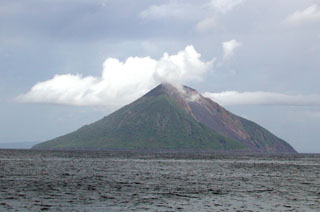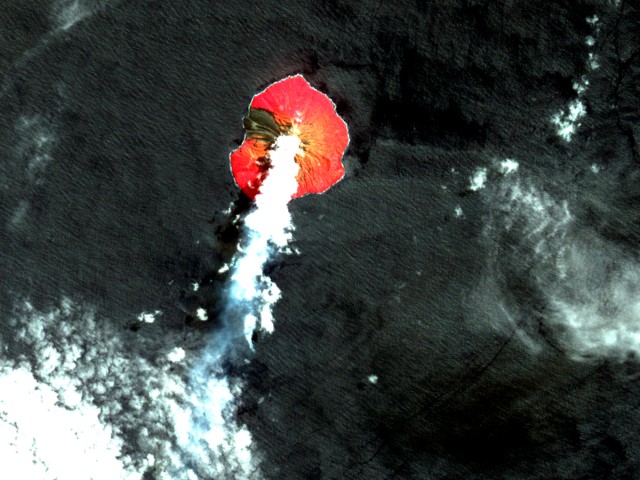Report on Tinakula (Solomon Islands) — January 2010
Bulletin of the Global Volcanism Network, vol. 35, no. 1 (January 2010)
Managing Editor: Richard Wunderman.
Tinakula (Solomon Islands) Erupting in September 2009; ongoing MODVOLC thermal alerts into 2010
Please cite this report as:
Global Volcanism Program, 2010. Report on Tinakula (Solomon Islands) (Wunderman, R., ed.). Bulletin of the Global Volcanism Network, 35:1. Smithsonian Institution. https://doi.org/10.5479/si.GVP.BGVN201001-256010
Tinakula
Solomon Islands
10.386°S, 165.804°E; summit elev. 796 m
All times are local (unless otherwise noted)
Tinakula displayed intermittent MODIS/MODVOLC satellite thermal alerts February 2006-November 2007, and September 2008-August 2009 (BGVN 31:03, 32:03, 32:07, 34:10). Ground observations are rare at this frequently active but uninhabited island.
No thermal alerts were recorded between 15 August 2009 and 16 January 2010, although there was a ground observation of "steam and smoke" above the summit and incandescent blocks rolling down the flanks in mid-September (BGVN 34:10). Thermal anomalies were detected between 17 January 2010 and 24 February 2010 (table 5).
Table 5. MODIS/MODVOLC satellite thermal alerts recorded at Tinakula during 1 January-7 March 2010. Courtesy of the Hawai'i Institute of Geophysics and Planetology (HIGP) Thermal Alerts System.
| Date | Time (UTC) | Pixels | Satellite |
| 17 Jan 2010 | 1150 | 1 | Terra |
| 28 Jan 2010 | 1130 | 1 | Terra |
| 28 Jan 2010 | 1435 | 1 | Aqua |
| 15 Feb 2010 | 1425 | 1 | Aqua |
| 19 Feb 2010 | 2329 | 1 | Terra |
| 20 Feb 2010 | 1135 | 2 | Terra |
| 20 Feb 2010 | 1440 | 2 | Aqua |
| 22 Feb 2010 | 1125 | 1 | Terra |
| 22 Feb 2010 | 1430 | 1 | Aqua |
| 24 Feb 2010 | 1415 | 1 | Aqua |
| 27 Feb 2010 | 1145 | 1 | Terra |
ASTER images of Tinakula over a wide date range are available from the Geological Survey of Japan's Image Database for Volcanoes. One such image (figure 7) shows activity from 13 April 2006 (BGVN 31:03). On the Flickr website there is an image of an eruptive plume on 27 August 2006.
Geological Summary. The small 3.5-km-wide island of Tinakula is the exposed summit of a massive stratovolcano at the NW end of the Santa Cruz islands. It has a breached summit crater that extends from the summit to below sea level. Landslides enlarged this scarp in 1965, creating an embayment on the NW coast. The Mendana cone is located on the SE side. The dominantly andesitic volcano has frequently been observed in eruption since the era of Spanish exploration began in 1595. In about 1840, an explosive eruption apparently produced pyroclastic flows that swept all sides of the island, killing its inhabitants. Recorded eruptions have frequently originated from a cone constructed within the large breached crater. These have left the upper flanks and the steep apron of lava flows and volcaniclastic debris within the breach unvegetated.
Information Contacts: Hawai'i Institute of Geophysics and Planetology (HIGP) Thermal Alerts System, School of Ocean and Earth Science and Technology (SOEST), Univ. of Hawai'i, 2525 Correa Road, Honolulu, HI 96822, USA (URL: http://modis.higp.hawaii.edu/); Global Earth Observation Grid (GEO Grid), National Institute of Advanced Industrial Science and Technology (AIST) (URL: http://geodata1.geogrid.org/vsidb/image/index-E.html); and Advanced Spaceborne Thermal Emission and Reflection Radiometer (ASTER) (URL: http://asterweb.jpl.nasa.gov).


